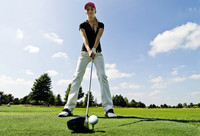

Special to the Recorder
Golf has long been heralded as one of the best ways to exercise the body and relax the mind. As in any sport, however, injuries can occur if you don’t take the proper precautions. Golf can be especially hard on the spine, often triggering back disorders. That’s why keeping one’s spines up to par is so important.
Focus on Posture
Proper posture – both on and off the course – is key to avoiding golf-related injuries and improving your game. For instance, a level backswing is dependent on proper posture. A backswing is actually two motions in one: the up/down movement of the arms and the rotation of the body, both directly dependent on spinal health.
That’s why a healthy spine is so vital to a golfer’s game. If the spine is out of alignment, the swing will be out of alignment. Low-back injuries are particularly common among golfers. Why does golf generate – and aggravate – low-back pain? According to researchers, the answer is two-fold: poor mechanics and today’s more demanding swing. Stiff hip and back muscles are often the root causes of flawed mechanics. Also, older golfers may have back conditions that the swing aggravates: The disks between the spinal vertebrae get less elastic with the years, and therefore are less able to distribute the stresses that the swing puts on the back.
Warm up – and stretch!
Warming up is essential when it comes to staying in the game. Despite overwhelming evidence supporting the need to warm up, however,most golfers remain cold to the idea. Few amateur players adequately warm up before practicing or playing a round of golf. If you don’t stretch prior to golfing, you are asking your body to play golf with an added handicap. Muscles that are warm and stretched properly prior to teeing off are supple and loose, which enables your body to perform to its full potential.
Why is stretching so important? Because jolting stiff muscles into action triggers muscle strain and vertebral subluxation. Additional benefits related to stretching and warming up are outlined in the Professional Golf Association (PGA) Tour Golf Academy Student Instruction Manual:
Greater swing flexibility and motion, allowing for a solid follow-through without straining any muscles
Improved muscle endurance
Fewer aches, pain - and lessened chance of injury
Increased enjoyment of the game
There are countless stretching exercises from which to choose. Start with a series of simple arm, neck and leg stretches. The key is to move slowly and deliberately, easing into each stretch and completing it fully. Also seek advice from your health care professional or athletic coach for suggestions on what stretches are best for you.
Cancel the Cart
Here’s a simple way to dramatically improve your fitness level: Choose to walk the course, rather than rent a cart. Walking elevates aerobic activity, increases stamina and boosts immunity, maximizing athletic performance and warding off injury.
Blame the Bag
Although golfers tend to blame back-related problems on suboptimal swings, many golf-related injuries have nothing to do with the actual game. Golf bags, by themselves, have substantial bulk and weight. Add to that the maximum number of clubs allowed during course play – a mix of 14 irons and woods along with a dozen or so balls and assorted accessories. The result? Enough weight to cause serious injury. Prevent bag-related injuries by asking your doctor to outline proper lifting techniques. In addition, never carry your bag from hole to hole. Instead, invest in a portable, hand-pull cart.
Stop for Soreness
Whoever said “no pain, no gain” was far off course. If you experience pain during an activity, whether on or off the golf course, stop! Pain is your body’s way of letting you know that there is a problem. It’s like the “check engine” light on your car’s dashboard. Rather than “playing through” pain, stop and seek medical advice to stave off more serious injury later on.
Golf is a game. It is also exercise. The No. 1 rule when embarking on a new exercise program is to seek advice from a qualified health care professional. To go from a sedentary to active lifestyle takes time and patience. Even if you are already actively involved in another sport, you may need to consider some modifications to your golf game until your body is fully up to par.
Dr. Erika Hamer is a chiropractic neurologist and owner of Ponte Vedra Wellness Center, with offices in Ponte Vedra Beach and Nocatee Town Center. Dr. Hamer also runs Ponte Vedra Training Company, specializing in doctor supervised training programs customized according to individual goals and physical limitations.